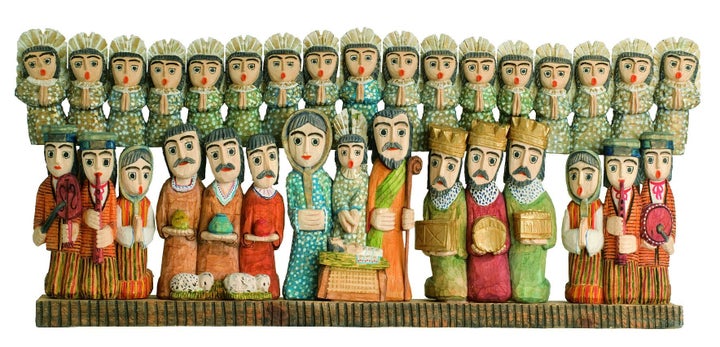
The images of the James and Emilia Govan Creche Collection come to us courtesy of the Loyola University Museum of Art with the introduction written by the Rev. Dr. Mark Bosco, SJ. HuffPost Religion thanks both for their generous collaboration.
The story of the Nativity, which the crèche represents visually, has its own unique history. Most of the figures of the crèche -- Jesus, Mary, Joseph, the angles, the shepherds and the Magi -- are in the gospels of Matthew and Luke combined, but the early church also had hidden gospels, or what we call apocryphal gospels, that speak about the origins and the end times of Christ.
These folk stories were never recognized by the Church because of their fanciful content and the late arrival on the scene (written 100 years after the four gospels in the Bible). But some of these folk gospels were important to the Nativity story. The Protevangelium of James in the third century, for instance, contains many improbably legends about the childhood of Mary, her courtship with Joseph, and the childhood of Jesus. The Gospel of Mary, probably even later than other writings and even more fanciful, mentions the long journey into Bethlehem on the same donkey that helped to warm the infant Jesus at his birth in the stable. So the first grasp of the significance of the Nativity story comes out of these stories, narrating the connection of Christian community to the life of Jesus, the family of Jesus, and to Mary and Anne, the first mother and the first grandmother of all Christians.
The devotion to the infancy of Jesus, precisely as encountered in the Nativity crèche, was inspired by Saint Francis of Assisi. In 1223, Francis asked permission from Pope Honorius III for a special observance of Christmas. Having received the pope’s consent, Francis set up a manger in a mountainside cave outside of Assisi, using a wooden infant Jesus and a live cow and donkey, so that the community could better encounter the simplicity of Christ’s birth. Francis saw the need to visualize in a tangible manner the events surrounding Christ’s birth in a medium that encourages participation by everyone -- the artist and the laborer, the wealthy and the poor, the clergy and the laity.
The devotion to the crèche grew over the next centuries. The heyday -- one might call it mania -- of the crèche was in Naples during the 16th and 17th centuries. The first recorded account of a crèche for a private home was for that of the Duchess of Amalfi in 1567. Her crèche was an extravagant 167 figures. Soon afterward, the crèche became common, if less elaborate, in private homes. Variations of it spread over Europe, but in each place it was rendered, the style of the crèche would be molded from the available resources and made by local artisans.
As Western European culture expanded to the Americas, Africa and Asia, the crèche followed as each culture made the Nativity scene its own. Wherever the crèche is rendered, artists give the figures features of their own cultures as on of the first artifacts of Christian enculturation. Whether highly stylized or folkloric, the crèche suggests that the human story and the divine story intersect and develop together.
